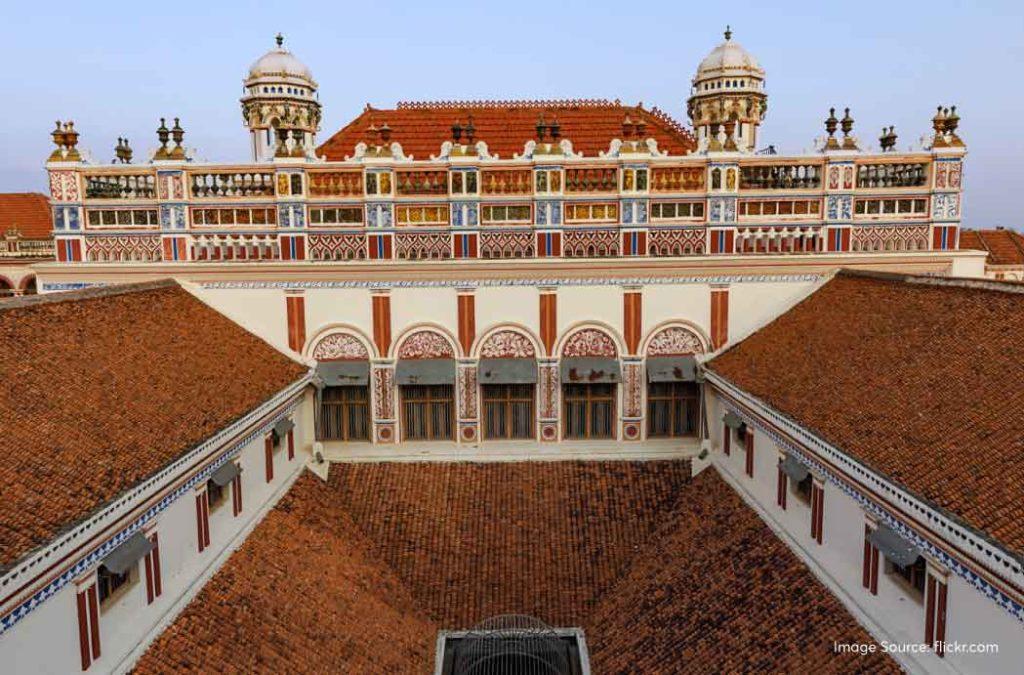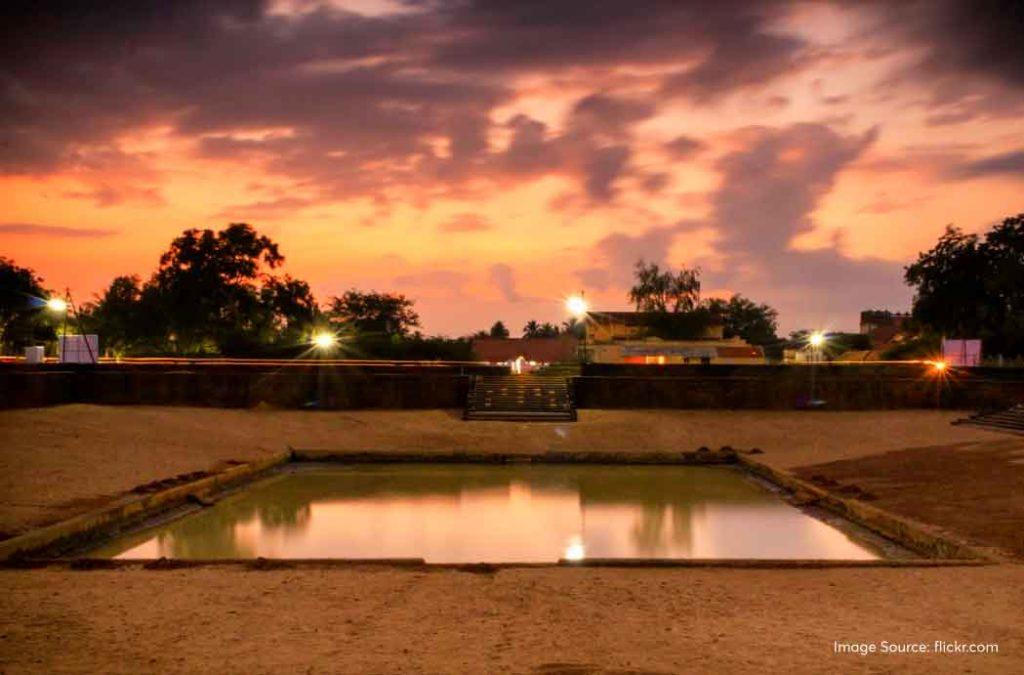Whenever we hear ‘Chettinad’, we instantly associate it with delicious food. The dishes are spicy and melt like magic on the tongue! However, Chettinad is more than just the culinary delights. The regal mansions will take you back to the era of Tamil Nadu kings, and the village men still follow the ancient traditions passed down from previous generations.

Chettinad is the perfect place to explore South India’s heritage! The land consists of a group of close-knit villages in the Sivaganga district of Tamil Nadu. The major town here is Karaikudi, which is also popular as Chettinad’s urban centre or main centre.
Beyond this, there is so much more to know about Chettinad. Read on to find out about the history, beauty of the village, architecture of the mansions, and interesting things to do while in Chettinad!
Also Read: 11 Places to Visit in Kumbakonam: Where Spirituality Meets Tranquility
The Chettinad History
If we break down the word Chettinad – ‘Chetti’ refers to the Chettiyars and ‘Nad/Nadu’ refers to land. Chettinad means the land of the ‘Chettiyars’. These people were from an affluent community of bankers who specialised in commerce and businesses. Apart from money management, they also indulged in the trade and sale of gemstones.

Chettiyars had their clients in a few European countries, Singapore, Malaysia, Burma and even Indonesia. They initially lived close to the spot where the Kaveri River joined with the Bay of Bengal. This way, they had enough fresh water for survival and could also stay close to the harbour for business.
Unfortunately, the area sunk to the sea after a major natural calamity hit the lands. The Chettiyar community then relocated to Karaikudi and reset things to how they were before. Their business flourished despite being away from the shores. It is said that the Chettiyars developed a fear of water and did not want to reconstruct their abodes anywhere near the ocean. Karaikudi became their main town for business operations and they started building their houses, and mansions here. Slowly, they started living in the neighbouring villages of Karaikudi as well and the region became known as ‘Chettinad’.
The beauty of Chettinad Village
The Chettiyar supremacy in Chettinad grew significantly during the 19th Century. The villages became vibrant with their mansions that had huge courtyards and at least 50 rooms inside. Even if the Chettiyar was not very rich and didn’t own a mansion, he was still well-off than the other villagers. They always had colourful houses.

When India attained independence, the Chettiyars started to migrate to other countries. Some travelled to Chennai to build better households while most of them are now settled in Malaysia and Singapore. When you reach Chettinad, you will see that the mansions and houses owned by these Chettiyars are now being cared for by their servants or caretakers.
Chettinad will show you the perfect glimpse of the magnificent mansions blending well with the rustic village set-up. You have the bullock carts carrying giggling children to school and can see beautiful women dressed in vibrant Chettinad sarees. The weather is very soothing for a cultural walk across the villages or even hiring a bullock cart for a one-day tour of the important places. Cycling is an adventurous alternative, especially on the interesting village roads lined by trees on either side.
Architecture of Chettinad Palaces
The Chettinad Palaces are magnificently beautiful and tell you a lot about the customs of the Chettiyars. Even today, some of their ancestors reside in the royal houses and lend a part of their properties for tourists to explore. The places where the owners reside are usually off-limits for visitors.

When you see a Chettinad palace, you should keep your eyes open for these splendid architectural wonders.
Valavu – It is the main courtyard of the house where the Chettiyars used to house the holy Tulsi plant. They offer morning prayers here and usually conduct ceremonies in the vast space. Chettiyars believed in extravagant celebrations and invited hundreds of guests for engagement or wedding ceremonies. Valavu is where they used to gather.
Pattagasalai – This hall was meant for professional gatherings where Chettiyars used to discuss business matters. The people of the villages were known to borrow money from the rich businessmen and this is where the debtors used to meet with their money lenders.
Visiri Hall – It is a grand hall with enough space to house hundreds to thousands of gifts. When women got married into the Chettiyar family, they used to get a lot of dowry in the form of money and lucrative gifts. All of them were displayed here for the world to see.
Darbar Hall – This is where the head of the family used to address the people of the village and the other businessmen who used to work under the Chettiyars.
Bommakottigai – This is a room that has colourful ceilings and a double-height space with beautifully sculpted dolls. These pretty dolls used to overlook the conversation of the ladies of the house while they giggled and gossiped about what was happening around the villages.
The best time to visit the Chettinad Villages

You can visit Chettinad villages anytime during the year, seeing how the grandeur of the palaces and the impressive green cover remain the same throughout. However, people prefer to come here from October to March as the winters make the weather much more pleasant and endearing.
7 things to do on your next trip to Chettinad
1. Chettinad Food

When you come to Chettinad, you should definitely try the local food served on a huge banana leaf. You will find a lot of rice-based dishes here, including the desserts. Most of the cuisines, including the non-veg meals, are prepared using coconut gratings and ground red chillies. The curries are usually spicy and savoury, a treat to the taste buds.
2. The Mansions

The Chettinad Palaces, or the Chettinad Mansions as some would call them, are the main attractions of the place. They are bright and colourful. They have a vast courtyard. The compound of the mansions is huge, usually lined by trees and plants. The insides are equally charming with gathering halls, high ceilings, wooden work, teak furniture and ample ventilation. Most of the Chettinad mansions are currently closed but the open ones are awe-inspiring and gorgeous.
3. Attangundi Tile Making

During British rule, imports and exports have come to a halt. The rich usually depended on Belgium tiles to make their mansion’s flooring attractive. Chettiyars needed an alternative and they found a perfect one. The wealthy bankers started aiding in the manufacture of tiles from river sand, cement and generous traces of mica and silica. They are the Attangudi tiles. You can go to the Attangudi village and see how the workers use the traditional tool, Kattam, to make interesting designs on the tiles.
4. Chettinad Sarees

Chettinad sarees are known for their unique weaving style and bold colour combinations. They have motifs of temples, mother nature, and Hindu mythology. Usually, they are made from cotton or silk and feel very light once you wear them. The local women are employed in the factories and the money from the job is the main source of livelihood for families. When the women in Chettinad wear the sarees, you will see that the fabric ends just a few inches above their ankles. The sarees are weaved intentionally in such a way that they are shorter than the usual sarees in your cities. Call it the Chettinad style, if you want to!
The hand weaving is absolutely captivating and you can also ask the women to teach you how it is done. They are more than happy to oblige. Chettinad sarees are not just limited to these villages and these days you find them everywhere. However, this is the right place to find the authentic ones, that too at wholesale prices.
5. Kolam Lessons

Remember the courtyard, Valavu, that we discussed? This is where they conduct Kolam classes now. Kolam is a communal art form that is very famous in the southern parts of India. It is slightly different from the conventional Rangolis. Intricate floral patterns are drawn using a series of dots that serve as the base for the design. Learning Kolam in the breathtaking palaces will prove to be a worthy experience.
You will see that Kolams are almost everywhere in Chettinad. In front of the houses, outside the temples, before the schools, and also in front of the holy Tulsi plants in the courtyards. The people here believe that Kolam will ward off evil and keep negativity at bay. It is considered auspicious and invites a lot of happiness and good health into the household.
6. Terracotta Horse Temple

Terracotta Horse Temple or the Ayyanar Temple is very famous among the people of Chettinad. They believe that ‘Ayyanar’ is the celestial deity who safeguards their villages and keeps them prosperous. The small temple is surrounded by paddy fields and soothing scenery. Here, you will find a lot of terracotta horses that are about 5 inches in height. In the month of March, the Chettinad residents perform a ritual where they offer terracotta horses to Ayyanar, asking him for wishes that they believe will be fulfilled after the offering.
You May Also Like to Read: Temples in Tamil Nadu: the Splendid Displays of Dravidian Heritage
7. Antiques Market in Karaikudi

When the Chettiyars left Chettinad and started to settle in foreign countries, they sold their strong furniture and other valuable items to the other locals. Whoever could afford them, bought them and flaunted the items for as long as possible. For years, they have changed hands and now rest in the antique market of Karaikudi.
When the mansions were abandoned, thieves robbed the places and looted the valuables – anything that they could sell to the goldsmiths or other people for a steep price. These have also changed hands and you will find all of the antiques in shops lining Karaikudi. From wooden doors to copper utensils, everything from the Chettiyars’ era is available here. If you can strike the right bargain, it is possible to grab the best ones at a very low price.
How to reach Chettinad?

Chettinad is a beautiful place and travelling to this destination is fairly easy. Karaikudi is the main village in Chettinad and this is where you must reach first to explore all other surrounding villages like Attangudi, Kanadukattan, and Kadiapatti.
By Air
People travelling by flight must reach Madurai International Airport first and then head toward Karaikudi. You will find local buses, taxi rides, and you can also travel by train from Madurai to Karaikudi. The journey takes about 2 hours to cover 92 km.
While you are in Madurai, book your stay at Treebo Hotels in Madurai to relax and rest before heading toward Karaikudi.
By Rail
Other cities in Tamil Nadu like Chennai, Coimbatore, and Tiruchirapalli are well connected with Madurai. You will find trains coming here daily and weekly. After reaching Madurai, you can board multiple trains that travel to Karaikudi.
By Road
People coming from any of the Indian states must reach Madurai first and then take a road trip toward Karaikudi. Madurai to Karaikudi road is smooth except for a few potholes and narrow paths. The best route would be the one passing through Melur and Tirupattur on NH38. NH383 also connects Madurai with Karaikudi. Enjoy the view of rippling paddy fields while you are at it!
Now that you know everything about Chettinad, it is your turn to pack your bags and reach Karaikudi! The other villages are within a 30km radius so it won’t be challenging to cover all of them. Explore the rich ethnic heritage of the place and understand the lavish lifestyle of the Chettiyars. Have the best food made from coconut and whole spices, while enjoying the heartwarming hospitality of the Chettinad locals. This is the perfect travel experience that you shouldn’t miss out on!








